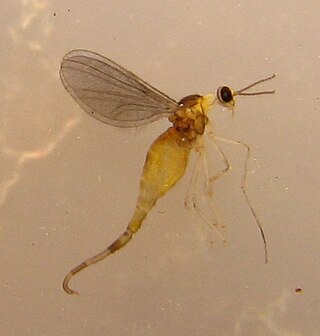
Sciaroidea is a superfamily in the infraorder Bibionomorpha. There are about 16 families and more than 15,000 described species in Sciaroidea. Most of its constituent families are various gnats.

The Cecidomyiinae, commonly known as gall midges or gall gnats, is the largest subfamily in Cecidomyiidae with over 600 genera and more than 5000 described species. This subfamily is best known for its members that induce galls on plants, but there are also many species that are fungivores, parasitoids, or predators as maggots.
Catotricha is a genus of midges in the family Cecidomyiidae. The five described species in Catotricha are found in the holarctic region. This genus was established by British entomologist Frederick Wallace Edwards in 1938.
Monardia is a genus of wood midges, insects in the family Cecidomyiidae. The 53 described species in Monardia are grouped into three subgenera.
Micromyinae is a subfamily of wood midges, insects in the family Cecidomyiidae. Its members were formerly included in subfamily Lestremiinae. There are at least 55 genera and more than 650 described species in Micromyinae. All species in this subfamily are mycophageous.
Haplusia is a genus of gall midges and wood midges in the family Cecidomyiidae. There are more than 20 described species in Haplusia.

Winnertzia is a genus of gall midges and wood midges in the family Cecidomyiidae. There are more than 90 described species in Winnertzia.
Lestremiinae is a subfamily of Cecidomyiidae. It is composed of 105 described species classified into 13 genera. The larvae feed on fungi, primarily in rotting wood.
Anarete is a genus of midges in the family Cecidomyiidae. There are 38 described species. The genus was established by Irish entomologist Alexander Henry Haliday in 1833 and has a cosmopolitan distribution.
Lestremia is a genus of midges in the family Cecidomyiidae. There are 18 described species in this genus. It was established by French entomologist Pierre-Justin-Marie Macquart in 1826.
Acoenonia is a genus of midges in the family Cecidomyiidae. The six described species are found in the holarctic region. The genus was first described by Arthur Earl Pritchard in 1947.
Antennardia is a genus of midges in the family Cecidomyiidae. The four described species are found in the Holarctic realm. The genus was first described by Boris Mamaev in 1993, but was subsequently treated as a subgenus of Monardia until being reinstated at the genus level.
Bryomyia is a genus of midges in the family Cecidomyiidae. The six described species are found in the Holarctic and Oriental regions. The genus was first described by Jean-Jacques Kieffer in 1895.
Groveriella is a genus of wood midges, insects in the family Cecidomyiidae. The two described species are known only from Europe. The genus was established by Boris Mamaev in 1978.
Heterogenella is a genus of wood midges in the family Cecidomyiidae. The twelve described species are found in the Holarctic and Oriental realms. The genus was established by Boris Mamaev in 1963.
Neurolyga is a genus of wood midges, insects in the family Cecidomyiidae. The 28 described species occur in the holarctic region. The genus was established by Italian entomologist Camillo Rondani in 1840.
Polyardis is a genus of midges in the family Cecidomyiidae. The ten described species are found in the Holarctic and Australasian realms. The genus was first described by entomologist Arthur Earl Pritchard in 1947.
Tropaprionus is a genus of wood midges, insects in the family Cecidomyiidae. There are seven described species in Tropaprionus.


